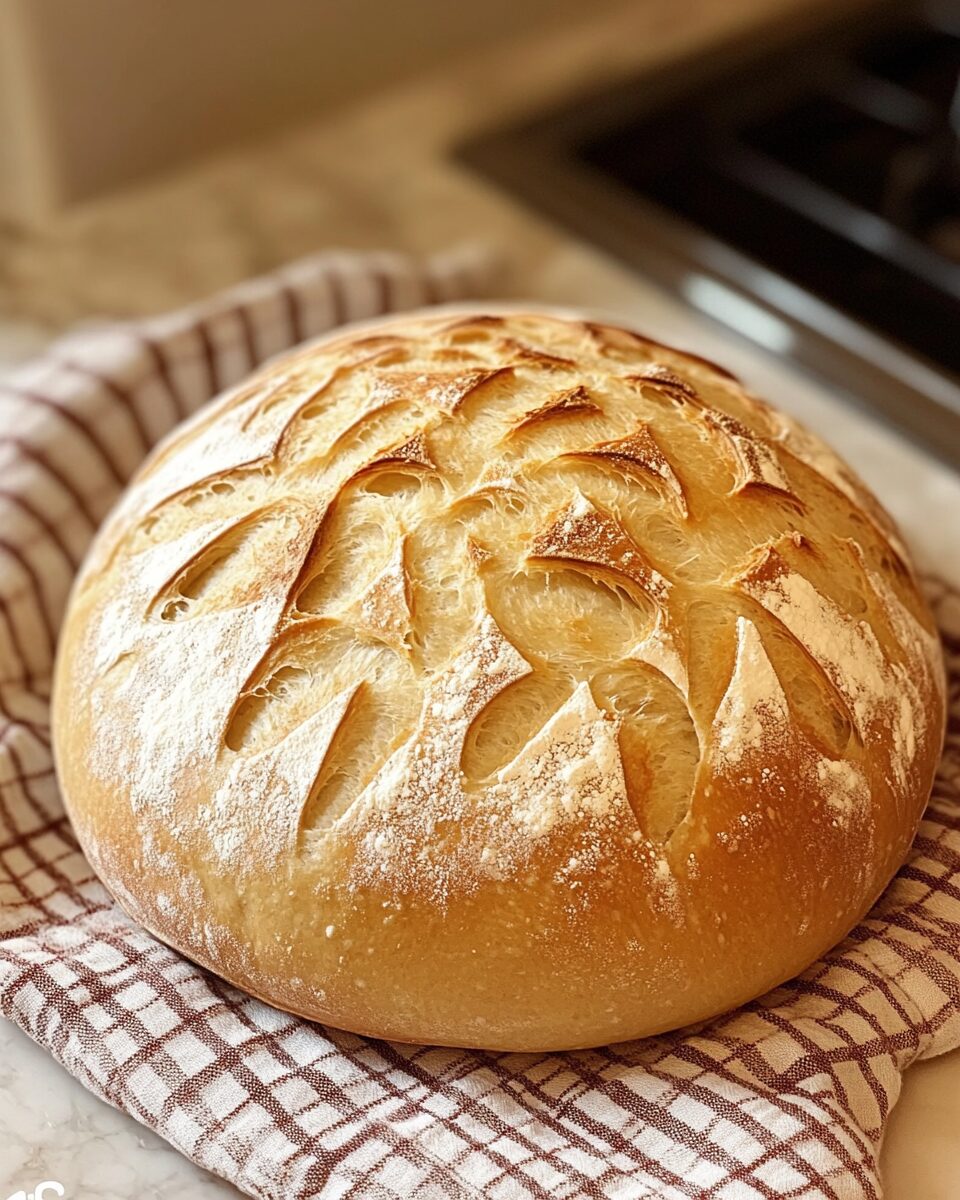Sourdough bread is the ultimate testament to the beauty of slow fermentation. With a crisp golden crust and an airy, chewy crumb, this homemade loaf delivers deep, tangy flavors that only natural leavening can achieve. The process may take time, but each step—from cultivating the starter to shaping the dough—builds anticipation for the final, delicious result.
Whether enjoyed simply with butter, toasted for sandwiches, or paired with soups and stews, this sourdough is versatile and nourishing. Plus, it’s made with just three ingredients, proving that simplicity often leads to the best flavors. With each slice, you’ll taste the love and craftsmanship that went into creating this artisan loaf.
Full Recipe:
Ingredients:
- 500g (4 cups) bread flour
- 100g (½ cup) active sourdough starter
- 325g (1⅓ cups) filtered water
- 10g (2 tsp) salt
Directions:
- Mixing the Dough: In a large mixing bowl, combine the sourdough starter and water. Stir until dissolved. Add the bread flour and mix until a rough dough forms. Let it rest for 30 minutes.
- Adding Salt: Sprinkle the salt over the dough and incorporate it by folding and pressing gently.
- Bulk Fermentation: Cover the bowl with a damp towel and let it rest at room temperature for 4-6 hours, performing a stretch and fold every 30 minutes.
- Shaping: Lightly flour a work surface and shape the dough into a round loaf. Place it in a floured proofing basket or bowl. Cover and refrigerate overnight (12-16 hours) for a long, cold fermentation.
- Preheating & Scoring: Preheat the oven to 475°F (245°C) and place a Dutch oven inside for 30 minutes. Carefully place the dough onto parchment paper, score the top with a sharp blade, and transfer it to the Dutch oven.
- Baking: Bake covered for 25 minutes, then remove the lid and bake for another 15-20 minutes until golden brown. Let the bread cool for at least an hour before slicing.
Prep Time: 12 hours (including fermentation) | Cooking Time: 45 minutes | Total Time: 12 hours 45 minutes
Kcal: 170 kcal per slice | Servings: 12 slices
Classic Sourdough Bread: A Timeless Artisan Delight
Sourdough bread is one of the oldest forms of naturally leavened bread, dating back thousands of years. Unlike commercial yeast-based bread, sourdough relies on wild yeast and lactic acid bacteria to ferment and rise, giving it its signature tangy flavor, chewy texture, and beautifully crisp crust. The process of making sourdough requires patience and attention to detail, but the rewards are well worth it.
The History and Origins of Sourdough
Sourdough has a rich history that spans different civilizations. It is believed to have originated in ancient Egypt around 1500 BC when bakers accidentally discovered that leaving flour and water to ferment produced a more flavorful and airy loaf. Since then, cultures worldwide have embraced and developed their own variations of sourdough bread.
During the California Gold Rush in the 1800s, sourdough became a staple for miners, who relied on its longevity and rich flavor. The term “sourdough” became synonymous with pioneers and adventurers, particularly in San Francisco, where bakers perfected the art of maintaining wild yeast cultures. Today, San Francisco-style sourdough is known for its intense tanginess and complex taste.
Why Sourdough Bread is Special
Sourdough is more than just another type of bread. It stands out because of its unique fermentation process, which not only enhances its flavor but also makes it easier to digest. The long fermentation allows beneficial bacteria to break down gluten and phytic acid, making it more gut-friendly compared to regular bread.
Another key characteristic of sourdough is its crust and crumb texture. The baking process, especially when done in a Dutch oven, creates a crispy, golden-brown crust while keeping the inside soft, airy, and flavorful. The natural acids developed during fermentation contribute to its complex, slightly tangy taste, making it a favorite among bread enthusiasts.
The Science Behind Fermentation
The magic of sourdough lies in its natural fermentation. Unlike commercial yeast, which provides a quick and predictable rise, sourdough uses a live culture of wild yeast and lactic acid bacteria to slowly ferment the dough. This slow process results in a more complex flavor profile and improved texture.
During fermentation, wild yeast breaks down sugars in the flour, producing carbon dioxide, which causes the dough to rise. Simultaneously, lactic acid bacteria contribute to the dough’s tanginess and help pre-digest the gluten, making it easier on the stomach. These bacteria also create acetic acid, which strengthens the gluten structure and enhances the shelf life of the bread.
The Art of Maintaining a Sourdough Starter
A sourdough starter is the heart of the bread-making process. This natural culture of wild yeast and bacteria is maintained through regular feedings of flour and water. Over time, it develops a distinct flavor, which is influenced by environmental factors such as humidity, temperature, and the type of flour used.
Many bakers name their starters and keep them for years, some even passing them down through generations. A well-maintained starter can last indefinitely if fed regularly and stored properly. The key to a healthy starter is consistency—feeding it at regular intervals and adjusting hydration levels based on room temperature and activity.
Choosing the Right Flour for Sourdough
The type of flour used can significantly impact the outcome of sourdough bread. Bread flour is commonly used due to its high protein content, which helps create a strong gluten network, leading to a well-structured loaf.
Whole wheat flour can be added for a more robust flavor and increased nutritional value. Rye flour, which contains a high amount of natural wild yeast, is often used to boost fermentation activity, especially when building a new starter. Experimenting with different flours can yield unique variations in flavor and texture, allowing bakers to customize their sourdough to their preference.
The Importance of Long Fermentation
One of the defining features of sourdough is its long fermentation process. Unlike conventional bread, which rises in a few hours, sourdough requires several hours or even overnight fermentation. This slow process allows the flavors to develop fully and gives the bread its signature tang.
A cold fermentation in the refrigerator enhances the complexity of the bread’s flavor, leading to a loaf with a deeper, more pronounced taste. This step also strengthens the dough, making it easier to shape and score before baking.
Scoring and Baking for the Perfect Loaf
Scoring the dough before baking is both an aesthetic and functional step. It allows the bread to expand properly in the oven, preventing uncontrolled bursts. Bakers use different patterns to create visually appealing designs, ranging from simple slashes to intricate artistic patterns.
Baking sourdough in a Dutch oven traps steam, which helps develop a crackly crust and allows the loaf to rise fully before the crust sets. The initial high heat encourages oven spring, leading to an airy, open crumb structure. Removing the lid halfway through baking promotes browning and creates the deep golden color that sourdough is known for.
Health Benefits of Sourdough Bread
Sourdough bread is not just delicious; it also offers several health benefits:
- Easier Digestion: The natural fermentation process breaks down gluten and phytic acid, making sourdough more digestible than conventional bread.
- Lower Glycemic Index: Sourdough has a lower glycemic index, meaning it does not cause a rapid spike in blood sugar levels.
- Rich in Probiotics and Prebiotics: The fermentation process promotes the growth of beneficial bacteria, which support gut health.
- No Preservatives or Additives: Unlike many store-bought breads, homemade sourdough contains only a few natural ingredients, making it a cleaner, healthier option.
How to Enjoy Sourdough Bread
Sourdough is incredibly versatile and can be enjoyed in various ways:
- Freshly Sliced with Butter: The simplest way to enjoy its full flavor.
- Toasted with Avocado and Eggs: A nutritious and filling breakfast option.
- As a Sandwich Base: Perfect for hearty sandwiches with meats, cheeses, and vegetables.
- With Soups and Stews: The crisp crust makes it an excellent pairing for warm, comforting meals.
- For Making Croutons or Bread Pudding: Leftover sourdough can be repurposed into delicious recipes instead of going to waste.
Troubleshooting Common Sourdough Issues
Baking sourdough can be a learning process, and beginners often face some challenges. Here are solutions to common problems:
- Dense or Heavy Loaf: This may be due to underproofing or insufficient fermentation time. Extending the bulk rise or allowing a longer cold fermentation can help.
- Flat Loaf: Overproofing or weak gluten structure can cause the dough to spread instead of rise. Ensure proper folding and shaping techniques.
- Tough or Hard Crust: This often results from baking at too high a temperature without enough steam. Using a Dutch oven helps retain moisture for a crisp yet tender crust.
- Too Sour or Not Sour Enough: Adjusting fermentation time and temperature can help control the tanginess. A longer cold fermentation leads to a stronger sour flavor.
Conclusion
Sourdough bread is an art form that combines tradition, science, and patience. From cultivating a thriving starter to mastering fermentation and baking techniques, each step contributes to a deeply flavorful and satisfying loaf. Unlike commercial bread, sourdough offers a complexity of taste, a crisp crust, and health benefits that make it truly special.
Whether you are a seasoned baker or a beginner exploring the world of homemade bread, sourdough is a rewarding and enriching journey. The process teaches patience, adaptability, and an appreciation for natural fermentation. With practice and dedication, you can create beautifully crafted loaves that delight the senses and nourish the body.






